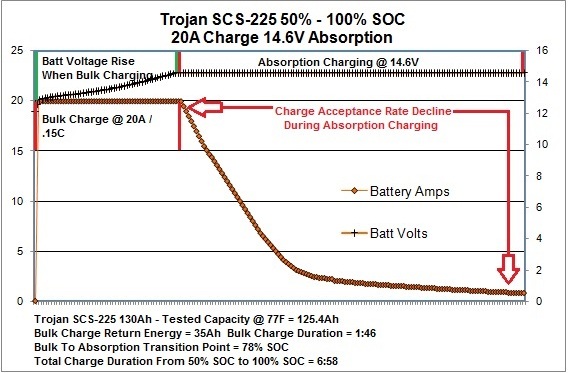Hi all,
I'd like to focus some questions for MaineSail if he's willing to pass on his fantastic knowledge and opinions but anyone, feel free to chime in also:
I'm planning a complete battery and charging system overhaul and upgrade for an 86 Hunter 40 Legend. Originally the boat had 2 8Ds, a 20 amp Charles AC charger, and the original 60(?) amp Yanmar alternator with an ASR-4 regulator. My first battery replacement cycle was to deep-six the 8Ds, replaced with 6 Group 31 12V 105 AH for 600-ish AH capacity, and upgraded to a 140A alternator. This current system is 7 years old now, batteries are done, regulator has failed, alternator still in good shape but never put out rated power due to single V-belt (learned about that from MS!) and time to retire the Charles AC charger.
So, here's the planned changes and upgrade options. Note: I am a pretty good craftsman, do most of my own work and not afraid to rip things out and rebuild/remodel for a better outcome.
Batteries (Trojan brand for all options): Option 1: 6 6V deep cycle golf cart. Will add optional watering system. 600+ AH total, dependable, mostly bullet-proof. Downside - won't fit current space due to height. Would require using carpentry skills to fit or relocate batteries. Option 2: 6V Gel. Almost as much AH, will fit current space (actually improves it). Downside - cost 2X, narrows charging options, possibly harder to replace in remote locales. Option 3: 12V Group 31 Gel. Equal AH bank to 6V Gel. My logic to 12V vs. 6V vs. 8D. If a 12V G31 battery fails, I can remove it and lose 1/6th of capacity. If a 6V fails, I lose 1/3rd. If an 8D fails, I lose 1/2. Even in the gel batteries, are the 6V still better than 12V, again assuming Trojans?
AC charger: Per MS recommendation, Sterling 60A Pro Charger with remote.
Alternator: Add either Balmar or Electromaxx serpentine belt kit to actually be able get all the amps from the alternator.
Regulator: open to suggestions before going with ASR-5 or equivalent.
I have a wind gen currently but will be adding solar soon. That's another topic entirely! Needless to say, all cables and wiring will be upgraded/replaced for the new install.
The cost of the Gel batteries doesn't scare me off, nor does AGM. Which is truly better? I like less maintenance and no need to equalize with the gels, that's why I want to go that direction. Still can't go wrong with plain old golf cart batteries though, if in the end they are the best option.
Thoughts and suggestions?
Thanks, Mark
I'd like to focus some questions for MaineSail if he's willing to pass on his fantastic knowledge and opinions but anyone, feel free to chime in also:
I'm planning a complete battery and charging system overhaul and upgrade for an 86 Hunter 40 Legend. Originally the boat had 2 8Ds, a 20 amp Charles AC charger, and the original 60(?) amp Yanmar alternator with an ASR-4 regulator. My first battery replacement cycle was to deep-six the 8Ds, replaced with 6 Group 31 12V 105 AH for 600-ish AH capacity, and upgraded to a 140A alternator. This current system is 7 years old now, batteries are done, regulator has failed, alternator still in good shape but never put out rated power due to single V-belt (learned about that from MS!) and time to retire the Charles AC charger.
So, here's the planned changes and upgrade options. Note: I am a pretty good craftsman, do most of my own work and not afraid to rip things out and rebuild/remodel for a better outcome.
Batteries (Trojan brand for all options): Option 1: 6 6V deep cycle golf cart. Will add optional watering system. 600+ AH total, dependable, mostly bullet-proof. Downside - won't fit current space due to height. Would require using carpentry skills to fit or relocate batteries. Option 2: 6V Gel. Almost as much AH, will fit current space (actually improves it). Downside - cost 2X, narrows charging options, possibly harder to replace in remote locales. Option 3: 12V Group 31 Gel. Equal AH bank to 6V Gel. My logic to 12V vs. 6V vs. 8D. If a 12V G31 battery fails, I can remove it and lose 1/6th of capacity. If a 6V fails, I lose 1/3rd. If an 8D fails, I lose 1/2. Even in the gel batteries, are the 6V still better than 12V, again assuming Trojans?
AC charger: Per MS recommendation, Sterling 60A Pro Charger with remote.
Alternator: Add either Balmar or Electromaxx serpentine belt kit to actually be able get all the amps from the alternator.
Regulator: open to suggestions before going with ASR-5 or equivalent.
I have a wind gen currently but will be adding solar soon. That's another topic entirely! Needless to say, all cables and wiring will be upgraded/replaced for the new install.
The cost of the Gel batteries doesn't scare me off, nor does AGM. Which is truly better? I like less maintenance and no need to equalize with the gels, that's why I want to go that direction. Still can't go wrong with plain old golf cart batteries though, if in the end they are the best option.
Thoughts and suggestions?
Thanks, Mark

